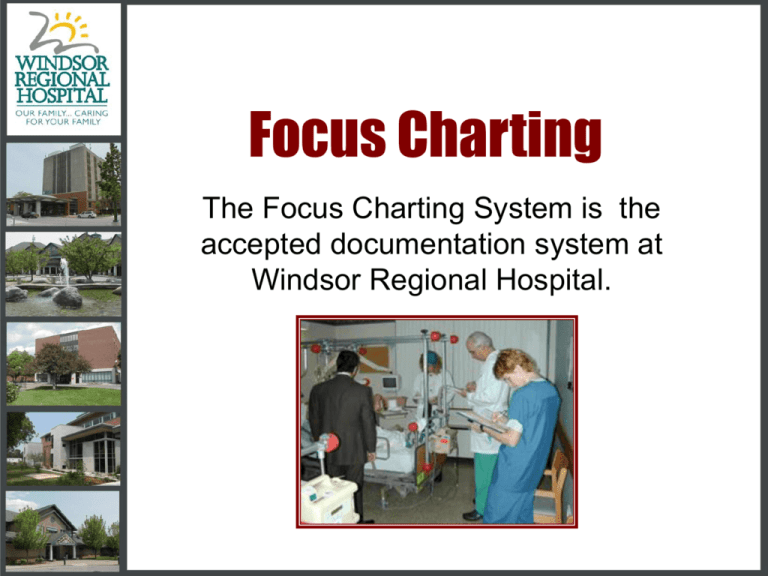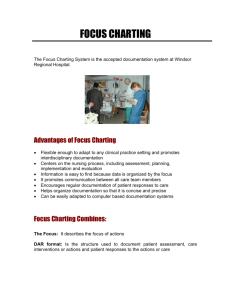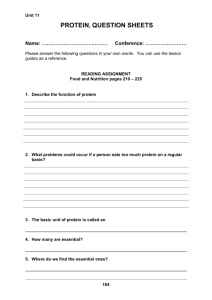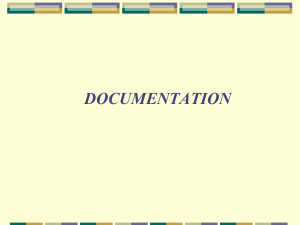Advantages of Focus Charting
advertisement

Focus Charting The Focus Charting System is the accepted documentation system at Windsor Regional Hospital. Advantages of Focus Charting • Flexible enough to adapt to any clinical practice setting and promotes interdisciplinary documentation • Centers on the nursing process, including assessment, planning, implementation and evaluation • Information is easy to find because data is organized by the focus. • It promotes communication between all care team members. Advantages of Focus Charting • Encourages regular documentation of patient responses to care • Helps organize document so that it is concise and precise • Can be easily adapted to computer based documentation systems Focus Charting Combines The Focus: It describes the focus of actions DAR format: Is the structure used to document patient assessment, care interventions or actions and patient responses to the actions or care The Focus System Uses: Progress Notes Focus Lists Flow Sheets Care Plans Developing the Focus Example Refers To A sign or symptom Hypotension, or chest pain A patient behaviour Inability to ambulate An acute change in the patient’s condition Loss of consciousness or increase in blood pressure A significant event in the patient’s therapy Surgery A special patient need Discharge planning need A focus may also be written in the format of a nursing diagnosis The Focus List A FOCUS LIST sheet is used as an index or quick reference for what you will find in the progress notes. All disciplines should record on the focus list • The focus is numbered in order that they are listed • Document the focus 1 2 Inability to ambulate Chest pain 11/12/01 Nursing, PT 11/12/01 Nursing • The date the focus is identified is indicated in the active column • The dates are entered if the focus is resolved or resinstated • The discipline entering the focus should identify themselves. The Focus List Additional Information about the Focus List • Focus Lists must be regularly updated and expanded as the patient’s condition changes • At discharge, focus list needs to be checked to ensure that all the foci have been addressed and / or resolved. The Use of Care Plans Once a focus has been identified, a plan of care needs to be documented. • All disciplines should have a plan of care. • “Care Plans” are included either as a standard nursing care plan or as an entry in the progress notes under the “A”. • Standardized care plans should be activated with the patient and/or significant other’s input in order to make it individualized. • Care plans should be regularly updated as required. Flow Sheets • There are numerous pre-printed flow sheets available at WRH • These are helpful in accurately and concisely documenting routine and frequently collected data • Use flow sheets whenever it is logical and helpful to do so. For example: Any documentation which is required on a regular basis by hospital policy or standard. • Any nursing care activity which is provided on a regular basis i.e. activities of daily living Flow Sheets Examples of Flow sheets are: • • • • • vital signs record, medication record, intake and output, post op flow sheet, wound assessment record Flow Sheets • All flow sheets must be correctly dated and must contain the patient’s name on both sides. • All entries on the flow sheets must be initialed (no use of check marks) by the person who assesses or provides the care and must have initials with full signature on a master copy. • Any variances from normal should be recorded in DAR format 01/12/02 JS JS JS JS Flow Sheets Do’s • Charting on the flow sheets should be done as the care is delivered or patient data observed • Develop assessment parameters that have meaning to everyone for example: Check abd incision q2h for drainage, redness, tenderness versus check incision • Make the flow sheets reflect the care needs of the patient • Be concise • Analysis of the trends in the patient data to assess if there are changes in the patients condition • Write legibly Don’ts • Don’t leave blanks • Don’t squeeze data into spaces provided. If not adequate space it is necessary to progress note • Double document in various parts of the charting system Progress Notes Are Used to: • Provide detail to data in a flow sheet. • Document patient response to care. • Record an unusual or unexpected event. record changes in patient condition and notification to the MD • Describe the status of the patient at the time of admission, transfer from one nursing unit to another, or at the time of discharge. Progress Notes When writing progress notes you should include information about: • The details about the patient’s condition (assessment data) • The interventions or nursing actions implemented and their effectiveness • The patient’s response to care How to Complete a Progress Note Nov. 12/01 1400 O.T. #1 -Swollen painful left hand.---------------- D - Assessment done as per referral----------Left hand swollen. Digits in extension.--Painful to passive ranging.--------------A - Discussed splint use and benefits with Pt. Splint molded. On-off schedule developed. R - Pt. concerned splint will be painful-----------------------------------K. Smith O.T. When starting a note the focus is documented first • Notes are chronologically entered. The date and time is documented in the columns provided. The time and date you are actually writing the note is used. • The service or discipline writing the note is recorded • In focus charting the structure of the progress note that follows the focus uses a DAR outline: Data, Action Response How to Complete a Progress Note Is an acronym Data - subjective & objective patient assessment data that supports the Focus Statement or describes observations of a significant event Action - immediate or future actions or plans of action or care based on the evaluation of assessment data Response - the patient response to the action taken. Progress Notes • The Response may not need to be immediately charted. There may not be an immediate response, therefore, only Data and Action may be charted Eventually, there should be a Response entered to that action taken Date 20 June 98 Time 1000 1230 Nrsg. Wound Dressing D - Moderate amount of purulent, foul smelling drainage from abdominal incision noted. Suture line red and swollen and warm to touch, T-39.5 complaining of pain at the site.-------------------------------------------------------A - Dr. B. Jones notified and informed of patient’s incisional status, orders received. Analgesic and antipyretic given as ordered, C&S of wound taken and sent to Lab. Wound cleansed with antibacterial solution and Joan Smith R.N. dry drsg. Applied.------------------------------------------------------------------------R - T38. Patient states incisional pain improving. Dressing remains dry and intact, no discharge noted. Antibiotic initiated as ordered. ----------------------------------------------------------------------------Joan Smith R.N. Joan Smith R.N. • There may be more than one focus that requires charting at one time • Progress notes must have a signature after each entry Progress Notes Date 22 June 98 Time 1500 Nrsg. #1 pneumonia D - pt. c/o of chest pain on inspiration, fatigue. T-39.5 at 1515, wheezy breath sounds, productive cough for purulent tenacious sputum. IV infusing. A - 02 at 3 litres, chest x-ray this am, sputum for C&S referral for chest physio. Tylenol ii for elevated temp at 1520. Fluids encouraged. R-T @1620 - 38---------------------Amy Nurse, RPN Write patient progress notes only when necessary. The goal is to minimize duplication of information and to save time. Focus Charting Do’s and Don’ts Progress notes can be improved by choosing language which is: • • • • Objective Precise Specific Thorough • Inconsistencies in documentation can leave you and the health care facility open to accusations of incompetence. • A medical record containing inconsistencies can be difficult to defend in court. • DO NOT use words like confused, uncooperative and depressed. These words may be interpreted in different ways and are not specific in accurately describing the patient Focus Charting Do’s and Don’ts Eats poorly Ate 1/2 the meal and drank 80 ml fluid Patient confused Patient unable to recognize family Uncooperative Refuses to assist with am care Patient complaining of pain Complaining of constant, sharp RUQ abd. Pain Good day Patient states has been pain free without medication and still able to complete activities of daily living Diuresing well Lasix 10 mg IV at 1430 resulted in 1000 ml of clear, yellow urine. Walking ad lib Walks around the unit, up to the elevator and back to room without any discomfort In Summary Be Factual Be Specific Be Precise Be Thorough Avoid Summarizing or using Value Judgements






